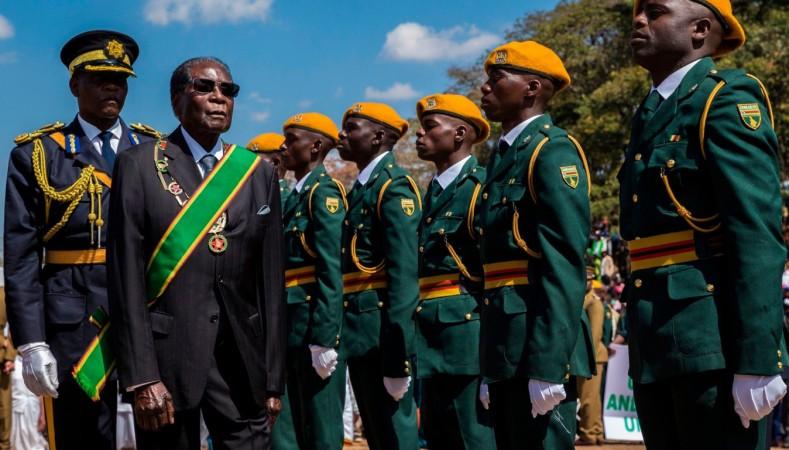Explore Marondera - Zimbabwe Travel, Africa
Nestled in the heart of Zimbabwe, Marondera is a hidden gem waiting to be discovered. Known for its tranquil landscapes, rich cultural history, and vibrant local life, this town offers a refreshing escape from the hustle and bustle of larger cities. For travelers who appreciate nature, Marondera provides a serene environment, surrounded by lush greenery and wildlife reserves. Marondera is located just an hour’s drive from the capital, Harare, making it an easy day trip or a peaceful weekend getaway. With a blend of natural beauty, fascinating cultural heritage, and welcoming locals, it’s an ideal spot for travelers seeking both relaxation and adventure.
Population: Approximately 66,000 in 2022.
Economy: Marondera's economy is primarily driven by agriculture, with tobacco, maize, and horticulture being key sectors. It also benefits from tourism, particularly due to nearby wildlife reserves.
Landmarks: Famous for the Gosho Park, Imire Game Park, and the Marondera National Heroes Acre.
Zimbabwe

Overview of Marondera
History & Cultural Influence
Marondera’s roots run deep in Zimbabwe’s history. Originally established as a colonial settlement in the late 19th century, it was first known as Marandellas. The town has evolved over the years from a colonial outpost into a thriving community deeply connected to the Shona people, Zimbabwe’s largest ethnic group. The influence of the Shona culture is palpable throughout the town, from the local language spoken by the residents to the traditional arts and crafts sold in its bustling markets. Visitors can experience this agricultural legacy through farm tours and visits to local markets where fresh produce and traditional Zimbabwean foods are readily available.
Interaction with The Locals
Marondera is home to a population of approximately 66,000 people. The majority of the people are of Shona descent, Zimbabwe's largest ethnic group. The Marondera people are noted for their warmth and kindness, as well as their strong sense of community. Agriculture is crucial to their livelihoods, with many people working on farms and local markets. While the town maintains traditional values, it is gradually modernizing, offering a blend of rural charm and emerging urban development.

Marondera, Zimbabwe - © New Zimbabwe
Top Attractions in Marondera
Marondera may be a small town, but it boasts an impressive array of attractions that showcase both its natural beauty and historical significance. Whether you enjoy nature or history, there is something here to pique your curiosity.
Gosho Park
If you enjoy outdoor activities, Gosho Park is a must-visit site. This nature reserve is known for its scenic walking trails, diverse wildlife, and birdwatching opportunities. The park is home to several types of antelope, zebras, and over 300 bird species, making it a perfect destination for nature lovers. Take a peaceful hike through its rolling hills, or enjoy a picnic while surrounded by the beauty of Zimbabwe’s natural landscape. The park is family-friendly and perfect for a relaxing day in nature.
Imire Game Park
For those seeking a more thrilling experience, Imire Game Park offers a chance to see Zimbabwe’s iconic wildlife up close. This conservation park is home to rhinos, elephants, and other wildlife species, all protected within its sprawling landscape. Imire is known for its dedication to rhino conservation, and visitors can learn about the efforts to protect these majestic animals while enjoying safari tours through the park. It's an incredible experience that lets you see Zimbabwe's wildlife in its natural habitat.
Marondera National Heroes Acre
History lovers should not miss a visit to the Marondera National Heroes Acre, a memorial site dedicated to Zimbabwe’s freedom fighters. This monument honors those who played a significant role in the country’s fight for independence. The site is a place of reflection, offering visitors a deeper understanding of Zimbabwe’s struggle for freedom and the individuals who sacrificed their lives for the nation.
Dombotombo Ruins
A lesser-known but fascinating historical site, the Dombotombo Ruins give visitors a glimpse into ancient Zimbabwe’s civilization. These stone structures, believed to date back to the time of the Rozvi Empire, are remnants of a once-thriving community. Exploring the ruins offers insight into the early history of the region and the architectural skills of its early inhabitants.

Marondera National Heroes Acre - © Zimbabwe Tourism
Must-Try Dishes in Marondera
Marondera's cuisine reflects Zimbabwe’s rich agricultural traditions, offering travelers an opportunity to taste the region’s fresh and locally sourced ingredients.
- Sadza: A staple across Zimbabwe, sadza is a thick maize porridge served with a variety of side dishes. In Marondera, it’s commonly paired with beef stew, leafy greens like covo, or beans. This hearty meal is a cultural cornerstone and widely enjoyed by locals.
- Nyama Choma: A favorite in social gatherings, Nyama Choma is marinated beef or goat grilled to perfection over an open flame. It’s typically accompanied by sadza or rice and relished during local events or outdoor markets.
- Matemba: Dried kapenta fish, known as matemba, is a popular dish in Marondera. It’s usually fried and served with sadza and leafy greens, delivering a salty, crunchy flavor that’s both simple and satisfying.
- Roasted Groundnuts (Nzungu): Locally grown groundnuts, or peanuts, are roasted and sold as snacks across Marondera. They make for a perfect light bite and are often found at street stalls or markets.
- Muriwo Unedovi: A popular local dish, muriwo unedovi consists of leafy greens cooked with a flavorful peanut butter sauce. The creamy texture and rich taste pair perfectly with sadza, making it a common meal in Marondera households.
- Boerewors: This spicy, coiled sausage of South African origin is widely enjoyed in Marondera, especially during barbecues and festivals. The sausage is grilled and served with a side of sadza or bread, offering a tasty and filling meal.

Sadza - © African Food Journal
Festivals & Local Celebrations
Marondera is a town that knows how to celebrate its heritage, and travelers have the opportunity to join in the festivities throughout the year. These local festivals offer a deep dive into the culture, history, and communal spirit of Marondera and Zimbabwe as a whole.
Zimbabwe Independence Day (April 18th)
A significant national celebration, Independence Day in Marondera is filled with parades, music, and dance performances that reflect the town’s patriotic spirit. The streets come alive with vibrant displays of Zimbabwean culture, from traditional dances to performances by local musicians. It’s a great time for visitors to witness the pride and history that runs deep in the community.
Zimbabwe Heroes Day (August)
Another important event, Heroes Day, honors Zimbabwe’s freedom fighters. Ceremonies are held at local memorial sites, including Marondera’s National Heroes Acre, where locals gather to pay tribute to the individuals who fought for the country’s independence. It’s a solemn yet powerful celebration that highlights the sacrifices made in Zimbabwe’s history.
Local Harvest Festivals
As an agricultural hub, Marondera hosts harvest festivals that celebrate the land and its bounty. These festivals are vibrant gatherings where locals express gratitude for their crops with food, music, and dance. Visitors can enjoy traditional dishes, meet local farmers, and experience the deep connection between the people and their land.

Zimbabwe Heroes Day - © The New York Times
What to Do in Marondera
Marondera offers a diverse range of activities for tourists, blending adventure with relaxation and cultural immersion. Whether you prefer exploring nature or learning about local traditions, the town provides plenty of options for travelers seeking enriching experiences.
- Safari Tours at Imire Game Park: Imire Game Park is one of the region’s premier wildlife reserves, known for its conservation efforts, particularly in protecting rhinos. Visitors can embark on guided safaris to see rhinos, elephants, and other wildlife in their natural habitats.
- Hiking in Gosho Park: Gosho Park offers beautiful hiking trails through its rolling hills and woodlands. The park is home to a variety of animal species, including zebras and antelopes, and offers a relaxing retreat into nature. Birdwatchers will also enjoy spotting the wide variety of birds that frequent the park.
- Horseback Riding: Horseback riding is a popular activity in the Marondera area, particularly at local farms and nature reserves. It’s a unique way to explore the surrounding countryside while enjoying the fresh air and scenic views.
- Birdwatching: Marondera is a prime location for birdwatchers, with over 300 species found in the area. Both Gosho Park and Imire Game Park are excellent spots for observing Zimbabwe’s vibrant birdlife. Pack your binoculars and enjoy a serene morning or afternoon spotting some of the rare species that call the region home.
Shopping in Marondera
Marondera’s markets and shops provide a wonderful opportunity for visitors to bring home a piece of Zimbabwean culture. The town is known for its vibrant marketplaces, where locals gather to sell fresh produce, handmade crafts, and unique souvenirs:
- Marondera Central Market: This bustling marketplace is a hub of activity and a great place to interact with the locals. Here, you can find fresh fruits, vegetables, and other farm products, reflecting Marondera’s agricultural roots.
- Shona Crafts and Sculptures: Marondera is one of the most famous stone carvings workshops in Zimbabwe. Local artisans craft intricate pieces from soapstone, serpentine, and other materials, showcasing Zimbabwe’s rich artistic heritage. These sculptures make for unique and authentic keepsakes.
- Textiles and Beadwork: Visitors can also explore stalls offering handmade textiles and beadwork. From colorful fabrics to intricately beaded jewelry, these items are crafted using traditional techniques passed down through generations.

Safari Tours at Imire Game Park - © Imire Rhino & Wildlife Conservation
Weather in Marondera: Best Time to Visit
Marondera enjoys a temperate climate, making it an appealing destination year-round. The town experiences distinct dry and rainy seasons, each offering unique experiences for travelers.
Dry Season in Marondera
The dry season is the best time to visit Marondera, with clear skies, cooler temperatures, and low humidity. Daytime temperatures average between 18°C to 25°C (64°F to 77°F), making it perfect for outdoor activities such as hiking, wildlife safaris, and exploring local markets. The cooler months of June to August can see nighttime temperatures drop, so packing a light jacket is recommended.
Rainy Season in Marondera
The rainy season brings lush landscapes and the chance to witness vibrant flora. Although the rains are generally heavy in the afternoons, mornings remain sunny and pleasant for sightseeing. Temperatures during this time range from 20°C to 30°C (68°F to 86°F). For travelers interested in birdwatching or exploring the countryside’s greenery, this season can be quite rewarding, but it’s wise to carry an umbrella or raincoat.

Dry Season at the savannah of Marondera - © Imire Rhino & Wildlife Conservation
Essential Travel Information
Getting Around Marondera
- Minibuses (Kombis): The most common form of public transport, minibuses or “kombis,” provide affordable rides around town and to nearby cities. They are widely used by locals, though they can be crowded.
- Taxis: Taxis are readily available in Marondera and are a convenient option for travelers who prefer more privacy or are unfamiliar with local routes. Taxis may be hailed on the street or booked via your hotel.
- Car Rentals: For those looking to explore the surrounding areas, renting a car is a great option. There are several rental agencies in Marondera and nearby Harare. The roads are generally in good condition, but it’s recommended to have a GPS or local map for navigation.
- Cycling and Walking: Marondera is small enough to explore on foot or by bicycle. Walking is a great way to experience the local culture and interact with residents. Many visitors enjoy leisurely walks or have a cycling tour to markets, parks, and historical landmarks.
ATM & Banking Service
Marondera provides several ATM and banking services to ensure easy access to cash for travelers. While ATMs are available in town, they can occasionally run out of cash, especially on weekends, so it's wise to withdraw early. International cards such as Visa and Mastercard are generally accepted at most ATMs, though fees may apply. It’s also advisable to have some cash on hand when visiting rural areas, as electronic payment options may be limited.
Where to Stay in Marondera
- Guesthouses: These guesthouses are family-run establishments, offering personalized service, home-cooked meals, and a welcoming atmosphere, making for an intimate stay with a chance to engage more closely with the community.
- Lodges and Safari Camps: For nature lovers, lodges and safari camps offer comfortable accommodations in close proximity to wildlife reserves. These lodges provide a chance to experience safari adventures while enjoying amenities such as guided tours, outdoor activities, and meals with scenic views of the surrounding nature.
- Hotels: Travelers looking for modern conveniences will find several hotels in town, offering services such as Wi-Fi, air conditioning, and on-site dining. These hotels are conveniently located near Marondera’s key attractions, providing easy access for those who prefer a more conventional lodging experience.
- Farm Stays: A unique option in Marondera is staying on a local farm, where visitors can experience rural life up close. Farm stays offer rustic accommodation combined with outdoor activities like horseback riding, hiking, or even participating in daily farm work, offering an immersive experience in Zimbabwe’s countryside.
Articles for you

Explore Yala National Park - Sri Lanka Travel, Asia
Tucked away in Sri Lanka’s southeastern corner, Yala National Park is where wild nature meets deep tradition. Known worldwide for its leopard population, the park is also home to elephants, sloth bears, crocodiles, and hundreds of bird species. Beyond wildlife, Yala opens doors to a cultural landscape dotted with ancient temples, Buddhist ruins, and coastal villages. For travelers seeking more than just a safari, Yala offers a chance to explore eco-tourism, local communities, and sacred heritage sites.
Population: The Yala National Park area doesn’t have a human population.
Economy: The economy around Yala National Park thrives on a blend of eco-tourism, agriculture, and local services. Safari tours, eco-lodges, and cultural experiences drive steady income for nearby towns like Tissamaharama and Kataragama, supporting thousands of families.
Landmarks: Famous for Block I of Yala and wildlife encounters, including elephants, sloth bears, crocodiles, and exotic bird species.

Explore Galle - Sri Lanka Travel, Asia
Nestled on Sri Lanka’s southern coastline, Galle is a vibrant city where history meets the sea. Its cobbled streets, colonial architecture, and serene beaches make it a must-visit destination for travelers seeking a blend of culture, adventure, and relaxation. A UNESCO World Heritage site, Galle captivates visitors with its Dutch Fort, bustling markets, and friendly locals. Whether you’re exploring the ramparts at sunset or savoring fresh seafood by the shore, Galle promises an unforgettable journey into Sri Lanka’s heritage.
Population: Approximately 113,000 in 2023.
Economy: Galle’s economy thrives on tourism, trade, and fisheries. The city’s historic fort, colonial architecture, and coastal charm draw thousands of international visitors each year, making tourism its main economic driver. Fishing remains vital for local livelihoods, supplying fresh seafood across the region.
Landmarks: Famous for the Galle Fort, Dutch Reformed Church & Maritime Museum, and Unawatuna Beach.

Explore Bentota - Sri Lanka Travel, Asia
Nestled along Sri Lanka’s southwestern coast, Bentota is a tropical paradise that blends golden beaches, vibrant culture, and thrilling adventures. Famous for its calm waters, luxury resorts, and scenic river estuary, Bentota has become a top destination for travelers seeking both relaxation and authentic experiences. From serene beach walks at sunrise to adrenaline-pumping water sports, this coastal town offers a perfect balance of leisure and exploration. With its proximity to Colombo and Galle, Bentota is easy to reach, making it an ideal stop for both short escapes and extended holidays.
Population: Approximately 37,000 in 2023.
Economy: Bentota’s economy thrives mainly on tourism, which drives local businesses such as hotels, restaurants, and wellness retreats. The town also benefits from fishing, coconut cultivation, and handicrafts like wood carving and batik textiles. Many residents rely on the growing demand for water sports and Ayurvedic treatments, making tourism the backbone of both income and employment in the area.
Landmarks: Famous for Bentota Beach, Bentota River Safari, and Kande Vihara Temple.

Explore Mirissa - Sri Lanka Travel, Asia
Mirissa is a charming coastal town on Sri Lanka’s southern shoreline. Known for its golden beaches, turquoise waters, and vibrant marine life, it has become a must-visit stop for travelers exploring the island. Many come for whale watching, surfing, and sunset views at Coconut Tree Hill, but Mirissa offers much more than postcard beauty. The fishing boats you see anchored by the bay carry generations of stories. Local traditions, delicious cuisine, and a laid-back rhythm of life shape every visitor’s experience.
Population: Approximately 4,700 in 2023.
Economy: Mirissa’s economy is largely shaped by its coastal location. Fishing has long been the backbone of local livelihoods, with generations relying on the Indian Ocean for income. In recent decades, tourism has become the main driver of growth, thanks to whale watching, surfing, and beachside hospitality.
Landmarks: Famous for Mirissa Beach, Coconut Tree Hill, and Parrot Rock Bridge.

Explore Nuwara Eliya - Sri Lanka Travel, Asia
Tucked away in the Central Highlands of Sri Lanka, Nuwara Eliya is often called “Little England”. With its rolling tea plantations, cool misty mornings, and colonial charm, this mountain town feels like a step into another world. Travelers come here to breathe fresh air, walk through flower gardens, sip the finest Ceylon Tea, and enjoy a pace of life far from the island’s busy cities. Whether you’re drawn by scenic landscapes, heritage architecture, or the warmth of its people, Nuwara Eliya is a destination that blends nature, culture, and history in perfect harmony.
Population: Approximately 781,000 in 2023.
Economy: Nuwara Eliya’s economy thrives mainly on tea production, as it sits in the heart of Sri Lanka’s central highlands, famous worldwide for Ceylon Tea. The city also benefits from a growing tourism industry, attracting visitors with its colonial charm, cool climate, and scenic landscapes.
Landmarks: Famous for Gregory Lake, Hakgala Botanical Garden, and Victoria Park.

Explore Sukau - Malaysia Travel, Asia
Nestled on the banks of the Kinabatangan River in Sabah, Malaysian Borneo, Sukau is a destination where wildlife, culture, and conservation come together. Known as one of Asia’s top spots for river safaris and eco-tourism, this quiet village offers a front-row seat to encounters with Bornean orangutans, pygmy elephants, proboscis monkeys, and exotic birdlife.
Population: Approximately 1,400 in 2019.
Economy: Sukau’s economy is shaped by its riverine location and natural resources. Traditionally, the Orang Sungai community relied on fishing, small-scale farming, and forest gathering for their livelihood. Today, the village has shifted toward eco-tourism, with river cruises, jungle trekking, and homestays providing income.
Landmarks: Famous for the Kinabatangan River cruises, Gomantong Caves, and Ox-bow lakes and wetlands.
